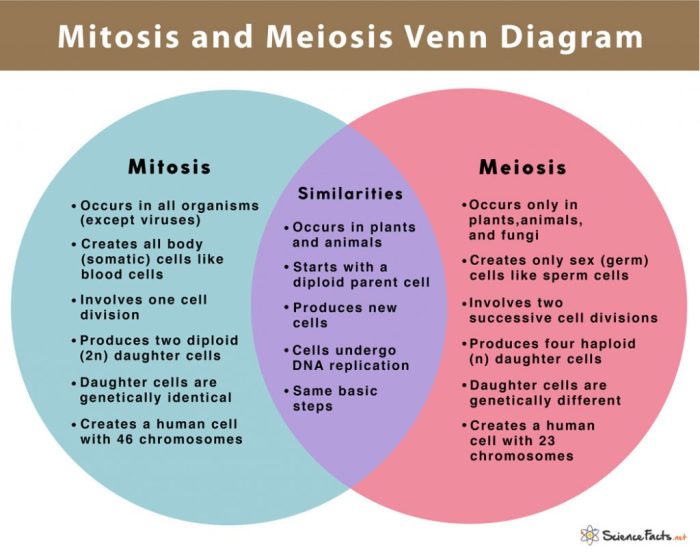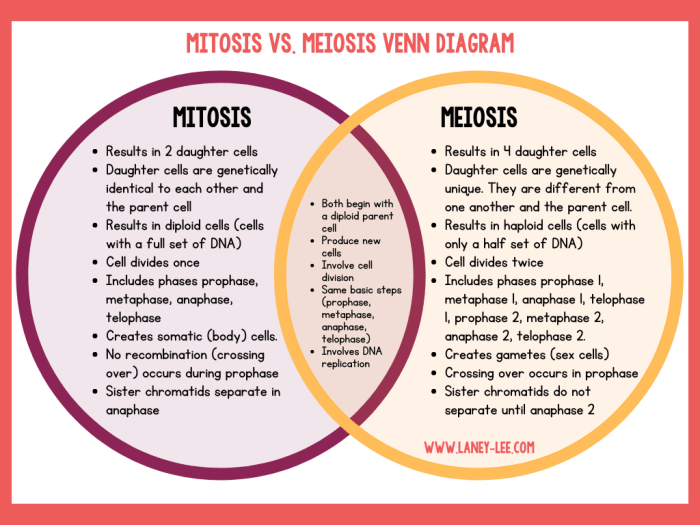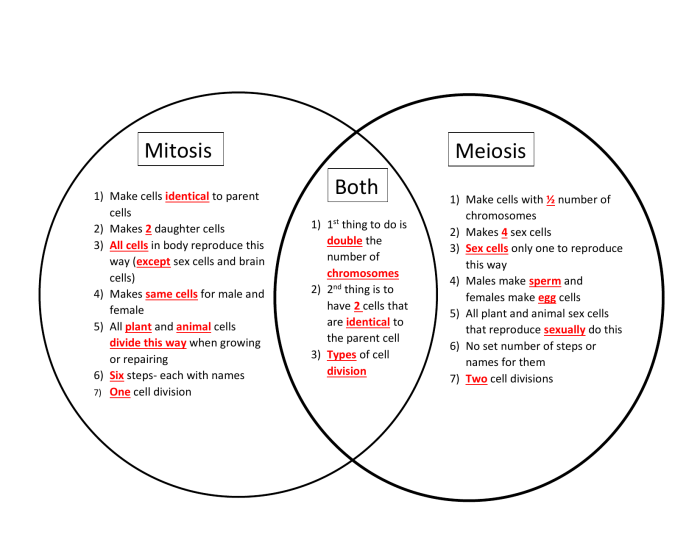The meiosis and mitosis venn diagram presents a comprehensive analysis of the fundamental processes of cellular division, providing a thorough understanding of their distinct roles in genetic variation and inheritance. This in-depth exploration delves into the intricacies of each process, examining their stages, chromosomal behavior, and practical applications.
Throughout this narrative, we will uncover the fundamental principles governing meiosis and mitosis, shedding light on their biological significance and their impact on various fields of scientific inquiry.
Overview of Meiosis and Mitosis

Meiosis and mitosis are two distinct types of cell division that occur in eukaryotic organisms. Mitosis is the process by which a cell divides into two identical daughter cells, while meiosis is the process by which a cell divides into four haploid daughter cells.
Both meiosis and mitosis are essential for the growth and development of organisms. Mitosis is responsible for the growth and repair of tissues, while meiosis is responsible for the production of gametes (eggs and sperm).
Key Differences Between Meiosis and Mitosis
The following table summarizes the key differences between meiosis and mitosis:
| Characteristic | Mitosis | Meiosis |
|---|---|---|
| Number of daughter cells | 2 | 4 |
| Ploidy of daughter cells | Diploid (2n) | Haploid (n) |
| Number of cell divisions | 1 | 2 |
| Synapsis | No | Yes |
| Crossing over | No | Yes |
| Purpose | Growth and repair of tissues | Production of gametes |
Biological Significance of Meiosis and Mitosis
Meiosis and mitosis are both essential for the survival and reproduction of organisms. Mitosis allows organisms to grow and repair their tissues, while meiosis allows organisms to produce gametes. Without meiosis, organisms would not be able to reproduce sexually, and without mitosis, organisms would not be able to grow or repair their tissues.
Stages of Meiosis and Mitosis

Meiosis and mitosis are two distinct cell division processes that occur in eukaryotic cells. Meiosis is a specialized type of cell division that produces gametes, or sex cells, while mitosis is the process by which somatic cells divide to produce two identical daughter cells.
Stages of Meiosis
Meiosis consists of two rounds of division, known as meiosis I and meiosis II. Each round of division is further divided into four stages: prophase, metaphase, anaphase, and telophase.Prophase I:
- Chromosomes become visible and condense.
- Homologous chromosomes pair up and undergo crossing over, exchanging genetic material.
Metaphase I:
Homologous chromosome pairs line up at the metaphase plate.
Anaphase I:
Homologous chromosomes separate and move to opposite poles of the cell.
Telophase I:
Two daughter cells are formed, each containing one chromosome from each homologous pair.
Prophase II:
- Chromosomes condense again.
- Spindle fibers form.
Metaphase II:
Chromosomes line up at the metaphase plate.
Anaphase II:
Sister chromatids separate and move to opposite poles of the cell.
Telophase II:
Four daughter cells are formed, each containing one chromosome from each original chromosome pair.
Stages of Mitosis
Mitosis consists of four stages: prophase, metaphase, anaphase, and telophase.Prophase:
- Chromosomes become visible and condense.
- Nuclear envelope breaks down.
- Spindle fibers form.
Metaphase:
Chromosomes line up at the metaphase plate.
Anaphase:
Sister chromatids separate and move to opposite poles of the cell.
Telophase:
Two daughter cells are formed, each containing one copy of each chromosome.
Progression of Stages in Meiosis and Mitosis
The progression of stages in meiosis and mitosis can be illustrated using a table or flowchart.|
- *Stage |
- *Meiosis I |
- *Meiosis II |
- *Mitosis |
|—|—|—|—|| Prophase | Crossing over occurs | No crossing over | Chromosomes condense || Metaphase | Homologous chromosomes line up | Chromosomes line up | Chromosomes line up || Anaphase | Homologous chromosomes separate | Sister chromatids separate | Sister chromatids separate || Telophase | Two daughter cells formed | Four daughter cells formed | Two daughter cells formed |
Chromosomal Behavior in Meiosis and Mitosis

Chromosomal behavior during meiosis and mitosis is fundamentally different, reflecting the distinct purposes of these processes. In meiosis, homologous chromosomes pair up and exchange genetic material through a process called crossing over, resulting in genetic diversity among offspring. In contrast, mitosis produces genetically identical daughter cells for growth and tissue repair.
Role of Homologous Chromosomes in Meiosis
Homologous chromosomes are pairs of chromosomes that share the same genetic information but may have different alleles. During meiosis, homologous chromosomes align and undergo crossing over, where sections of DNA are exchanged between them. This process generates new combinations of alleles, increasing genetic diversity and contributing to the evolution of species.
Illustrations of Chromosomal Behavior, Meiosis and mitosis venn diagram
The following illustrations depict the chromosomal behavior in meiosis and mitosis:
- Meiosis:
- During prophase I, homologous chromosomes pair up and undergo crossing over.
- In metaphase I, the homologous chromosome pairs align at the metaphase plate.
- In anaphase I, the homologous chromosomes separate and move to opposite poles of the cell.
- In telophase I, two haploid daughter cells are formed, each containing one chromosome from each homologous pair.
- Mitosis:
- During prophase, the chromosomes condense and become visible.
- In metaphase, the chromosomes align at the metaphase plate.
- In anaphase, the sister chromatids of each chromosome separate and move to opposite poles of the cell.
- In telophase, two genetically identical daughter cells are formed, each containing the same number of chromosomes as the parent cell.
Genetic Variation and Meiosis

Meiosis is a crucial process in sexual reproduction that contributes significantly to genetic variation, the cornerstone of evolution and adaptation. This variation arises from two primary mechanisms: crossing over and independent assortment.
During meiosis, homologous chromosomes pair up and undergo crossing over, a process where sections of DNA are exchanged between them. This results in the creation of new chromosome combinations, each carrying a unique blend of genetic material from both parents.
Role of Crossing Over
- Creates new gene combinations, increasing genetic diversity.
- Allows for the exchange of beneficial alleles between chromosomes.
- Contributes to the formation of novel phenotypes and traits.
Independent Assortment
In addition to crossing over, independent assortment plays a vital role in genetic variation. During meiosis, the chromosomes line up randomly at the equator of the cell, ensuring that each gamete (egg or sperm) receives a unique combination of maternal and paternal chromosomes.
- Ensures that each gamete carries a different set of chromosomes.
- Increases the likelihood of producing offspring with diverse genetic makeups.
- Promotes the survival and adaptation of species in changing environments.
The combination of crossing over and independent assortment during meiosis generates a vast array of genetic variation, providing the raw material for natural selection to act upon. This variation is essential for the evolution of new species, adaptation to changing environments, and the overall survival and success of life on Earth.
Applications of Meiosis and Mitosis
Meiosis and mitosis play crucial roles in various fields, including medicine, agriculture, and biotechnology.
Meiosis in Genetic Engineering and Assisted Reproductive Technologies
Meiosis is utilized in genetic engineering techniques to create genetically modified organisms (GMOs). By manipulating meiotic processes, scientists can introduce specific traits into crops, enhancing their nutritional value, resistance to pests and diseases, and overall yield.
In assisted reproductive technologies, such as in vitro fertilization (IVF), meiosis is essential for producing viable gametes (eggs and sperm). By understanding meiotic processes, scientists can optimize fertilization rates and improve the chances of successful pregnancies.
Mitosis in Tissue Repair and Growth
Mitosis is fundamental for tissue repair and growth throughout an organism’s lifespan. When cells are damaged or die, mitosis allows for the production of new cells to replace them, ensuring the maintenance and regeneration of tissues and organs.
During development, mitosis is responsible for the formation of all tissues and organs, starting from a single fertilized egg. It allows for the precise replication and distribution of genetic material, ensuring that each new cell receives an identical copy of the genome.
Commonly Asked Questions: Meiosis And Mitosis Venn Diagram
What are the key differences between meiosis and mitosis?
Meiosis is a specialized form of cell division that reduces the chromosome number by half, resulting in the production of haploid gametes (eggs and sperm). Mitosis, on the other hand, is the process by which somatic cells divide, resulting in two genetically identical daughter cells with the same chromosome number as the parent cell.
How does meiosis contribute to genetic variation?
Meiosis promotes genetic variation through two primary mechanisms: crossing over and independent assortment. Crossing over involves the exchange of genetic material between homologous chromosomes, while independent assortment ensures that each gamete receives a random assortment of chromosomes from each parent.
What are the practical applications of meiosis and mitosis?
Meiosis is essential for sexual reproduction and the production of gametes. Mitosis, on the other hand, is crucial for tissue growth, repair, and the maintenance of multicellular organisms.